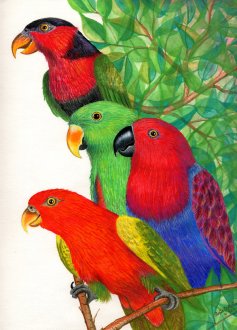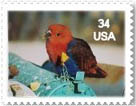
|
||
|
(painting by Susie Christian) |
||
Since my only roommates consist of nine Eclectus, and a plain olí garden variety, Red Lory, I do have an opinion that they are very related. First of all, the most obvious is the feather quality. Eclectus have hair-like feathers covering their heads and neck, and as I look at my lory, she also has soft, fine "hair-feathers." The general body shape and head structure of both parrots is also very close in my opinion. The loryís beak is so close in color to the male Eclectus; plus, shape-wise, it looks like an elongated Eclectus beak. My lory is allowed the run of the house 24 hours, so I am able to watch her climb all over the Eclectus cage, and interact with them. Her favorite playmate is a male Biaki Eclectus, who is extremely animated and playful. The Biaki subspecies is on the small end of the Eclectus group, about the size of a Solomon Eclectus. They are never still for a minute. Inquisitive and charged with energy, the Biakis have an electric tension that equals and sometimes surpasses that of my lory. These pint sized Eclectus hang upside down from their perches, and are constantly into everything. Animation should be their middle name! I also find my Red-sided Eclectus is more active than the Vosmaeri Eclectus (which is one of the largest of the Eclectus). It seems the larger they are, the more laid back they become. One of the loryís favorite positions is laying on her back, not surprising for a lory. I also have two eclectus hens that are very comfortable on their backs. They do sea otter imitations of "riding the waves" in Morro Bay, quite comfortably in public, even with groups of people watching them. I feel that the talking abilities are about the same in lories and Eclectus. My lory says all the same words as does the Eclectus. Yes, the Eclectus do have a more slender tongue than other species of parrots and Iíve noticed that they use their tongues in a more probing motion, which is so much like the lories. As for food selection, both groups of birds (Eclectus and lories) will pick out berries, grapes, pomegranates or any nectar-type of fruit as their first choice from the food dish. Both groups will throw out the boring stuff, only to investigate much later. I have noticed that neither group really want to use a foot to hold their food. They will pick food up with their beaks but will place it back in the food dish rather than hold it in one of their feet. Whether readers will agree with me or not, I sincerely feel that somewhere back in time (who knows how far), that both lories and Eclectus were much more similar in appearance and that they evolved over the years to look as they appear today. They used to be brothers and sisters; nowadays it is probably more like first cousins! |
||
|
Also read: † † Photography by Susie Christian© |


